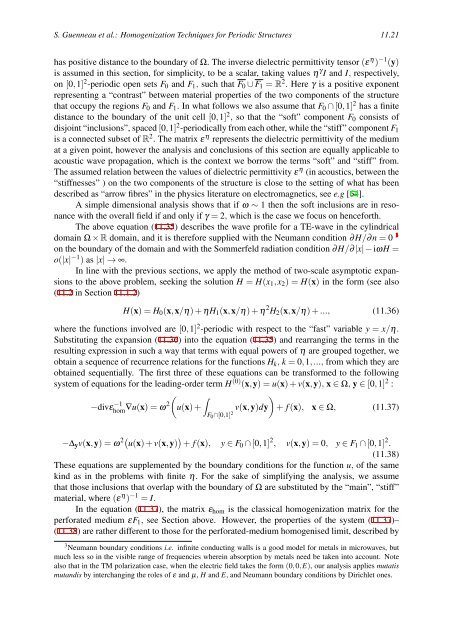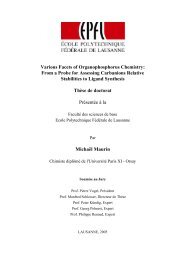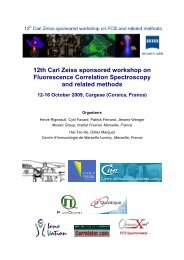GratinGs: theory and numeric applications - Institut Fresnel
GratinGs: theory and numeric applications - Institut Fresnel
GratinGs: theory and numeric applications - Institut Fresnel
You also want an ePaper? Increase the reach of your titles
YUMPU automatically turns print PDFs into web optimized ePapers that Google loves.
S. Guenneau et al.: Homogenization Techniques for Periodic Structures 11.21<br />
has positive distance to the boundary of Ω. The inverse dielectric permittivity tensor (ε η ) −1 (y)<br />
is assumed in this section, for simplicity, to be a scalar, taking values η γ I <strong>and</strong> I, respectively,<br />
on [0,1] 2 -periodic open sets F0 <strong>and</strong> F1, such that F0 ∪ F1 = R 2 . Here γ is a positive exponent<br />
representing a “contrast” between material properties of the two components of the structure<br />
that occupy the regions F0 <strong>and</strong> F1. In what follows we also assume that F0 ∩ [0,1] 2 has a finite<br />
distance to the boundary of the unit cell [0,1] 2 , so that the “soft” component F0 consists of<br />
disjoint “inclusions”, spaced [0,1] 2 -periodically from each other, while the “stiff” component F1<br />
is a connected subset of R 2 . The matrix ε η represents the dielectric permittivity of the medium<br />
at a given point, however the analysis <strong>and</strong> conclusions of this section are equally applicable to<br />
acoustic wave propagation, which is the context we borrow the terms “soft” <strong>and</strong> “stiff” from.<br />
The assumed relation between the values of dielectric permittivity ε η (in acoustics, between the<br />
“stiffnesses” ) on the two components of the structure is close to the setting of what has been<br />
described as “arrow fibres” in the physics literature on electromagnetics, see e.g [64].<br />
A simple dimensional analysis shows that if ω ∼ 1 then the soft inclusions are in resonance<br />
with the overall field if <strong>and</strong> only if γ = 2, which is the case we focus on henceforth.<br />
The above equation (11.35) describes the wave profile for a TE-wave in the cylindrical<br />
domain Ω × R domain, <strong>and</strong> it is therefore supplied with the Neumann condition ∂H/∂n = 0 3<br />
on the boundary of the domain <strong>and</strong> with the Sommerfeld radiation condition ∂H/∂|x|−iωH =<br />
o(|x| −1 ) as |x| → ∞.<br />
In line with the previous sections, we apply the method of two-scale asymptotic expansions<br />
to the above problem, seeking the solution H = H(x1,x2) = H(x) in the form (see also<br />
(11.2 in Section 11.1.2)<br />
H(x) = H0(x,x/η) + ηH1(x,x/η) + η 2 H2(x,x/η) + ..., (11.36)<br />
where the functions involved are [0,1] 2 -periodic with respect to the “fast” variable y = x/η.<br />
Substituting the expansion (11.36) into the equation (11.35) <strong>and</strong> rearranging the terms in the<br />
resulting expression in such a way that terms with equal powers of η are grouped together, we<br />
obtain a sequence of recurrence relations for the functions Hk, k = 0,1,..., from which they are<br />
obtained sequentially. The first three of these equations can be transformed to the following<br />
system of equations for the leading-order term H (0) (x,y) = u(x) + v(x,y), x ∈ Ω, y ∈ [0,1] 2 :<br />
( ∫<br />
)<br />
u(x) +<br />
+ f (x), x ∈ Ω, (11.37)<br />
−divε −1<br />
hom∇u(x) = ω2<br />
v(x,y)dy<br />
F0∩[0,1] 2<br />
−∆yv(x,y) = ω 2( u(x) + v(x,y) ) + f (x), y ∈ F0 ∩ [0,1] 2 , v(x,y) = 0, y ∈ F1 ∩ [0,1] 2 .<br />
(11.38)<br />
These equations are supplemented by the boundary conditions for the function u, of the same<br />
kind as in the problems with finite η. For the sake of simplifying the analysis, we assume<br />
that those inclusions that overlap with the boundary of Ω are substituted by the “main”, “stiff”<br />
material, where (ε η ) −1 = I.<br />
In the equation (11.37), the matrix εhom is the classical homogenization matrix for the<br />
perforated medium εF1, see Section above. However, the properties of the system (11.37)–<br />
(11.38) are rather different to those for the perforated-medium homogenised limit, described by<br />
3 Neumann boundary conditions i.e. infinite conducting walls is a good model for metals in microwaves, but<br />
much less so in the visible range of frequencies wherein absorption by metals need be taken into account. Note<br />
also that in the TM polarization case, when the electric field takes the form (0,0,E), our analysis applies mutatis<br />
mut<strong>and</strong>is by interchanging the roles of ε <strong>and</strong> µ, H <strong>and</strong> E, <strong>and</strong> Neumann boundary conditions by Dirichlet ones.













